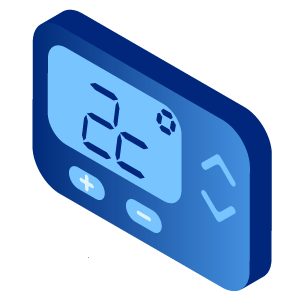Smart meter guide: All you need know
As people are becoming more conscious about their electricity bills, particularly at a time of rising costs, more UK households are switching to smart meters. These devices, connected via a wireless network, allow you to control your gas and electricity use - information that is also shared with your energy provider. In this guide, we’ll look at the types of smart meters available, how they work, the benefits, and costs involved.

Carbon footprint offsetting with Climate Consulting
Schedule a call with our consultants to find out how you can reduce your company's emissions.
What is a smart meter?
Smart meters are devices that record and monitor your gas and electricity usage in real time and give accurate data to avoid you receiving unexpectedly high energy bills. They have been introduced in the UK over the past few years to replace the traditional gas and electricity meters - usually located in a cupboard under your stairs - in which a representative from your energy supplier had to come to your home and take the estimated reading.
The smart meter contains two main elements:
- The meter: a secure, smart data network connected via wireless connection that sends information about your energy usage to your supplier;
- In-home display (IHD): a monitor - which looks like a tablet device - on which you can see your energy use and make alterations as you need.
What does a smart meter look like? Smart meters look fairly similar to traditional gas or electricity meters. They will be located in a cupboard or under the stairs and have buttons on them so you can scroll through and see different information on a small screen. In addition, you will also have an IHD, which looks like a tablet device.
How do smart meters work?
Smart meters work in a similar way to mobile phones - by using a wireless network connection. Your gas smart meter, electricity smart meter, and in-home device are in ‘contact’ with each other exchanging information.
In simple terms, the electricity smart meter is connected to the mains and monitors how much electricity you are using in real time. Gas smart meters tend to be battery powered and give readings at intermittent periods throughout the day. The smart meter is also connected to the wider Data Communications Company (DCC) network, which basically means your energy supplier also has access to your energy data recordings.
Does a smart meter need WIFI?No. Your smart meter does not need a WIFI connection, and will not be connected to the WIFI even if you have it installed in your home. Smart meters communicate with the IHD via a secure national network which is designed solely for their use.
What types of smart meters exist?
The Government started rolling out smart meters around 10 years ago, and today, there are two types of smart meters: SMETS1 and SMETS2 smart meters. SMETS stands for Smart Metering Equipment Technical Specification. According to Which.co.uk, when the initial roll-out of smart meters occurred more than 15 million were installed in homes across the nation.
However, a technical issue with the first generation of meters (SMETS1) meant they lost their smart functions when customers switched energy suppliers - meaning a new generation of upgrades smart meters (SMETS2) had to be developed. Households that have SMETS1 can have the problem solved and regain smart capabilities if they switch providers. But there may be a small period of time where meter readings need to be taken manually.
How do I know if my smart meter is SMETS1 or SMETS2?Smart meters have serial numbers on them and looking at that it may be possible to tell what type you have. If it starts with 19P, it is likely to be a SMETS1, while if it begins with 19M, it is probably a SMETS2 meter. However, Energy Review advises that if you are unsure about which type of smart meter you have, the best bet is to contact your energy supplier to confirm.
Install smart meter: What to do?

As part of the Government’s efforts to tackle climate change and reduce the amount of carbon dioxide (CO2) being emitted as a nation, it plans for all UK households to be offered a smart meter by 2025 and is aiming for 27 million to have been installed by then.
Each energy supplier has their own plan and timings to install smart meters in their customer’s homes and businesses. For installation dates, it is best to contact them directly. It is important to know that the switch from traditional energy meters to smart meters is free of charge - you do not need to pay for installation.
When the time comes to have a smart meter installed, such as an Octopus energy smart meter, Eon smart meter, British Gas smart meter, EDF smart meter, or SSE smart meter top up - your supplier will contact you and arrange a date to install it. On average, it takes around 90 minutes to install a smart meter - although that may vary depending on where your energy meters are located, what type of property you live in, and indeed whether you own your property or rent it.
How to read a smart meter?Once installed, you will be able to read your meter readings at any point and monitor your use of gas and electricity. The Citizens Advice Bureau offers detailed advice on how to read your gas smart meter and your electricity smart meter. However, when your smart meter is installed, the technician will also give you detailed advice on how to read your meter.
Can you get a smart meter while on a pre-payment plan?
Some UK households are not signed up on permanent contracts with their energy supplier but opt for pre-payment plans. Energy suppliers will offer smart meters to customers on pre-payment plans. People who are considered to be in a vulnerable or low-income group are protected by law and will be able to continue doing smart meter top ups online after they are installed.

Don't know what your company can do for the planet?
Contact our carbon offset department and we will advise you.
Why you should or shouldn't get a smart meter? Is it worth getting a smart meter?
When it comes to making the decision to switch to a smart meter - just like any choice you make to try and reduce energy use such as installing solar panels, or a heat pump - there are always advantages and disadvantages. In this section, we’ll look at the benefits and downsides of smart meters, and let you decide.
Advantages of smart meters
The main benefits of having a smart meter installed in your home are:

- You can track your usage and spend: through monitoring your usage on your IHD you can reduce both your electricity and gas use. This can both reduce your bills as well as your impact on the environment - meaning you can help our collective efforts to limit global warming;
- No need to submit meter readings: if you get a smart meter, gone are the days of having a technician come round to your house to take readings, or crawl under your stares to take the readings every month;
- No estimated bills: homeowners have sometimes received unexpectedly large energy bills which were based on their estimated energy use over a period of time. With a smart meter, bills are based on the exact usage - so no more unwanted surprises;
- Identify electrical issues: by monitoring your energy use on you IHD, you will be able to see if there are any unusual spikes - which could point to faulty electric appliances;
- Change energy behaviours: a smart meter can go a long way to increasing consciousness about what energy we use and how we use it. Research by Smart Energy GB published on Lookaftermybills.com estimates that by 2030, there could be a 24% decrease in emissions thanks to smart meters - something that would go a long way in helping the UK meet its emission targets agreed at COP26 in 2021.
Are there any disadvantages to smart meters?
On the other side of the argument, there are a few downsides to be wary of, including:
- Smart meter problems: While technology generally makes our lives easier, there can also be teething problems. As mentioned previously, smart meters can suffer various issues - such as the SMETS1 losing smart functions when switching suppliers;
- Poor network coverage: Have you ever experienced a loss of mobile phone signal when in rural or remote areas? Smart meters could suffer with similar ‘signal’ issues. Eventually, the aim is for all UK homes to have smart meters but you may have to wait slightly longer if you live in remote areas of the country, your home has thick walls, you live in a high rise block of flats, or your gas and electricity meters are located far apart;
- Not all energy providers can install smart meters: As of yet, not all energy providers install smart meters. Check with your energy provider if they do. If not, consider switching - perhaps even to a provider of green energy;
- Watch your usage: While the idea behind smart meters is to make better energy choices to reduce your usage and your bills, having one won’t automatically do so. It is up to you to ensure you watch your IHD and make the changes you need to - such as unplugging phone chargers, or turning the TV off rather than leaving it on standby.
Smart meter not working: What to do?There are a number of reasons why smart meters may stop working but all have a straightforward solution. These reasons include when switching suppliers, when the smart meter is connected to solar panels, possible issues over billing issues, the IHD stops working because of poor connection. In all cases, you should contact your supplier as soon as possible and they will investigate the problem and issue new meters or IHDs if necessary - free of charge.
Read more of our guides and advice for more information on how you can reduce your impact on the environment and help tackle climate change.
